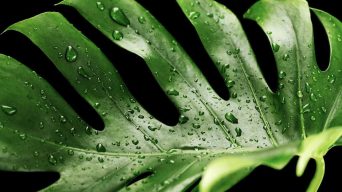To encourage faster growth in your Monstera plant, ensure it receives adequate light, preferably bright indirect sunlight. Additionally, provide a well-draining soil mix and water the plant consistently, allowing the top few inches of soil to dry out between waterings. Regularly fertilizing with a balanced houseplant fertilizer during the growing season can also promote faster growth.
Growing your Monstera, or Swiss cheese plant, is an adventure filled with lush, tropical beauty.
However, do you ever find yourself staring at your stately Monstera, wishing it would hurry up and sprout those magnificent fenestrations a little faster?
Unlocking the secret to turbo-charging your Monstera’s growth isn’t as tricky as you might think. Dive into our world of greenery, where we unravel top tips and techniques to speed up your Monstera’s growth spurt.
We will explore the vital role of light and temperature and uncover the magic of fertilizers, pruning, and repotting in boosting plant vigor. Fasten your seatbelts; we’ll turn your patience into flourishing foliage before you know it!
Facts and Statistics
- Studies show that in optimal conditions, a Monstera plant can produce a new leaf every 4 to 6 weeks.
- With the right balance of light, water, and nutrients, a mature Monstera can double in size in a year.
- A study published in the International Journal of Botany found that Monstera plants grown under 70-85% shade showed better growth compared to no shade or full sunlight.
Creating the Ideal Environment for Monstera Growth
Creating the ideal environment for your Monstera plant is essential to ensure its growth and overall health.
Here are some key factors to consider in creating an optimal environment for your Monstera’s growth:
- Lighting: Monstera plants thrive in bright, indirect light. Place them near a window with filtered sunlight or use a sheer curtain to prevent direct exposure.
- Temperature: Monstera plants prefer temperatures between 60-85°F (15-29°C). Avoid exposing them to extreme temperature fluctuations or drafts.
- Humidity: These tropical plants enjoy high humidity levels. Use a humidifier or place a water tray near the plant to increase humidity, especially during dry climates or winter months.
- Watering: Provide adequate watering by allowing the top inch (2.5 cm) of soil to dry before watering again. Overwatering can lead to root rot, while underwatering can cause dehydration.
- Soil: Use well-draining potting soil with good moisture retention properties. A mix of peat moss, perlite, and orchid bark works well for Monstera plants.
- Fertilization: Feed your Monstera plant with a balanced liquid fertilizer once every one to two months during the growing season (spring and summer). Reduce fertilization during winter months.
- Pruning: Regularly prune your Monstera plant to encourage bushier growth and remove any damaged or yellow leaves.
- Support: As Monstera plants grow, they develop aerial roots that benefit from support structures like moss poles or trellises.
Taking these factors into account will help you create an optimal environment for your Monstera plant’s growth, ensuring its health and longevity.
Lighting
Good lighting is crucial for Monstera plants to grow faster and develop bigger leaves.
While they prefer lots of light, direct sunlight should be avoided as it can lead to leaf burn. Instead, provide them with bright, indirect light.
Placing them near a north or east-facing window is usually ideal. If you don’t have access to natural light, using artificial grow lights can be a great alternative.
Imagine placing your Monstera near a south-facing window where it receives intense direct sunlight throughout the day.
You notice that the leaves start developing brown patches or spots, which indicates leaf burn caused by excessive sunlight exposure.
Moving the plant to a spot with indirect light allows it to thrive without any damage.
| Lighting Conditions | Effects on Monstera Growth |
|---|---|
| Direct Sunlight | Can cause leaf burn and damage |
| Bright Indirect Light | Promotes healthy growth |
| Now that we’ve identified the importance of lighting, let’s discuss temperature control when growing Monstera plants. |
Temperature Control
Monstera plants prefer warm temperatures ranging from 65°F (18°C) to 85°F (29°C). They can tolerate slightly cooler temperatures but don’t thrive in cold environments below 60°F (15°C).
It’s important to keep them away from drafts or sudden temperature changes as these can stress the plants. Maintaining a relatively consistent temperature helps create a stable environment for their growth.
Consider having your Monstera placed near an air conditioning vent where it constantly experiences cold gusts of air whenever the system is running.
You notice that the leaves start to yellow and droop, indicating stress caused by temperature fluctuations. Relocating the plant to a spot away from drafts helps restore its vitality.
Humidity and Ventilation
Humidity plays a vital role in the growth and overall health of Monstera plants. These tropical beauties thrive in humid environments that mimic their natural habitat.
Adequate humidity ensures optimal leaf development, prevents dryness and browning, and encourages vigorous growth.
Maintaining the ideal humidity level can be achieved through various methods. One effective technique is using a humidifier to increase the moisture content in the air.
Place the humidifier near your Monstera or within the same room to create a micro-environment that mimics its native rainforest conditions.
If investing in a humidifier isn’t feasible, there are alternative approaches to boost humidity.
Placing a tray filled with water near your plant or grouping multiple plants together can create a microclimate with increased humidity levels. The water will gradually evaporate, raising the humidity around the plants.
Let’s say you have a Monstera plant that’s not thriving as fast as you’d like it to. You could try placing a tray of water beside it and observe if it makes any noticeable difference in its growth rate.
Another factor to consider alongside humidity is proper ventilation.
While high humidity is beneficial, stagnant air can cause problems such as fungal diseases or stagnant growth.
Ensure there is adequate airflow around your Monstera by positioning it near open windows or using fans for circulation.
Essential Care and Maintenance for Monstera Plants
To ensure your Monstera grows at its best, providing proper care and maintenance is crucial. Let’s dive into some key aspects you should prioritize:
- Light Requirements: Monstera plants thrive in bright, indirect light. While they appreciate good light conditions, direct sunlight should be avoided to prevent leaf burn. A spot near a window with filtered light or a few feet away from a bright, sunny window is ideal.
- Watering: Regular and consistent watering is important to keep your Monstera healthy. However, be cautious not to overwater, as Monstera plants are prone to root rot. Water when the top inch of soil feels dry and observe the leaves for any signs of drooping or curling, which can indicate thirst.
- Soil and Potting: Monstera plants prefer a well-draining soil mix. A recommended choice is a chunky aroid mix consisting of an organic potting mixture, horticultural charcoal for conditioning and aeration, pumice instead of perlite for better water drainage, and a moisture retention substrate like moss. A suitable-sized pot that provides room for growth but isn’t excessively large is essential to prevent waterlogging.
- Climbing Support: Monstera plants are natural climbers and benefit from having something to climb on, such as a moss pole or trellis. This support encourages upward growth and helps the plant mature by developing its iconic fenestrations or leaf perforations.
Just imagine how stunning your Monstera would look as it climbs up a moss pole, showcasing its beautifully perforated leaves as it grows.
Think of caring for your Monstera like nurturing a friendship – it requires consistency (regular watering), the right environment (proper lighting and ventilation), and support (climbing structure) to grow strong and thrive.
Remember that each plant may have individual care needs based on factors such as location, climate, and age. Observe your Monstera closely and make adjustments accordingly.
With proper care and attention, your Monstera will reward you with its vibrant foliage and impressive growth.
Watering and Fertilization Techniques
Proper watering and fertilization techniques play a vital role in the growth of your Monstera plant.
Finding the right balance is key to ensuring healthy and faster growth.
Let’s dive into some techniques that can help you achieve optimal results.
When it comes to watering, Monstera plants prefer a consistent but not excessive moisture level in their soil.
Overwatering can lead to root rot, while underwatering can cause stress and stunted growth.
The general rule of thumb is to water your Monstera when the top inch of soil feels dry to the touch. Insert your finger or a moisture meter to check the moisture level before each watering session.
Now, there may be varying opinions on watering frequency, depending on factors like temperature, humidity levels, pot size, and drainage capabilities.
Some experts suggest allowing the soil surface to dry out slightly between waterings, while others recommend keeping the soil consistently moist but not soggy.
It’s essential to observe your plant’s behavior and adjust watering accordingly. Remember, it’s better to underwater than to overwater.
For instance, if your Monstera’s leaves start curling or drooping, it could be a sign of underwatering. In such cases, give it a thorough soak and monitor its response.
On the other hand, if you notice yellowing leaves or an unpleasant smell from the soil, it might indicate overwatering, so hold off on watering for a few days.
Fertilizer can also boost the growth of your Monstera plant, but it’s important to use it judiciously.
Avoid overfertilizing, as this can lead to salt buildup in the soil and burn the roots. Instead, opt for a balanced houseplant fertilizer and follow the instructions provided by the manufacturer.
A general practice is to fertilize every month during the growing season (spring and summer) and reduce or stop fertilization during the dormant period.
Role of Pot Size in Monstera Growth
The size of the pot you choose for your Monstera plant significantly impacts its growth rate.
The right pot size allows for proper root development while preventing issues such as waterlogging or overcrowding.
Let’s understand the role of pot size in more detail.
When selecting a pot for your Monstera, opt for one that is only 2 to 3 inches larger in diameter than the root ball. A snug fit provides stability and helps promote healthy root growth.
A pot that is too big can hold excess moisture, leading to root rot, while a pot that is too small can restrict root expansion, hindering overall growth.
Imagine wearing shoes that are either too loose or too tight. In both scenarios, it would impede your movement and cause discomfort.
The same applies to your Monstera; it needs a pot that accommodates its growing roots while providing an appropriate drainage system.
Additionally, consider using a well-draining soil mix specifically formulated for aroids.
A chunky aroid mix typically consists of organic potting mixture as the base, horticultural charcoal for conditioning and aeration, pumice instead of perlite for better moisture retention, and moss or orchid bark for air pockets and root support.
Some gardeners may argue that repotting your Monstera into larger pots regularly will result in faster growth.
However, frequent repotting can disrupt the plant’s root system and cause unnecessary stress. It’s best to repot only when necessary, usually once every two to three years, or when you notice the roots becoming pot-bound.
By selecting the appropriate pot size and providing your Monstera with a well-draining soil mix, you create optimal growing conditions that allow the roots to thrive. This, in turn, supports healthy foliage growth and overall plant development.
Choosing the Right Container
When promoting your Monstera plant’s growth, selecting the right container is a crucial step.
The container you choose should provide an optimal environment for your plant’s roots to thrive and expand.
Here are a few factors to consider when choosing the right container for your Monstera:
- Size of the Pot: It’s important to choose a pot that is not too large or too small for your Monstera plant. A pot that is too small can restrict root growth and cause your plant to become root-bound. On the other hand, a pot that is too large can retain excess water, leading to root rot. Aim for a pot that allows for 2 to 3 inches of space around the root ball, allowing room for growth without drowning the roots.
- Drainage Holes: Adequate drainage prevents waterlogged soil and root rot. Ensure that the pot you choose has drainage holes at the bottom to allow excess water to escape. You can also consider using a saucer or tray underneath the pot to catch any additional water and prevent it from sitting in stagnant puddles.
- Material of the Container: When it comes to material, there are several options available, including terracotta, plastic, ceramic, and fabric pots. Terracotta pots are popular due to their porous nature, allowing better airflow to the roots and preventing overwatering. Plastic pots, on the other hand, retain moisture well and are lightweight. Ceramic pots offer aesthetic appeal but may not be as breathable as terracotta. Fabric pots provide excellent drainage and air circulation but may require additional support.
Choosing an appropriate container for your Monstera plant is essential for providing a healthy growing environment. Consider these factors carefully to ensure optimal conditions for your plant’s growth.
Tips for Boosting Monstera Growth Speed
If you’re looking to accelerate the growth of your Monstera plant, there are some tips and techniques you can incorporate into your care routine.
While it’s important to remember that plants have their own natural growth rate, and pushing them too hard may not be sustainable, these tips can help create optimal conditions for faster growth.
Here are a few strategies to consider:
- Provide Adequate Light: Monstera plants thrive in bright, indirect light. Place your plant near a window where it can receive plenty of natural light throughout the day. However, be cautious about exposing your plant to direct sunlight, which can lead to leaf burn.
- Optimize Watering: Proper watering is crucial for healthy growth. Ensure you water your Monstera plant when the top inch of soil feels dry. Overwatering can lead to root rot, while underwatering can cause stress and hinder growth.
- Fertilize Regularly: Fertilizer can provide an extra boost to your Monstera’s growth. Use a balanced houseplant fertilizer during the growing season (spring and summer) according to the recommended dosage on the package. This will provide essential nutrients that support healthy foliage development.
- Prune and Propagate: Pruning your Monstera plant can promote branching and encourage new growth. Remove any yellow or damaged leaves, as these can divert energy from healthy leaves. Also, propagating healthy cuttings can produce new plants that will grow alongside the mother plant.
- Maintain Adequate Humidity: While Monstera plants can tolerate regular household humidity levels, providing slightly higher humidity can support their growth. You can increase humidity by using a humidifier nearby or placing a water tray near your plant.
Remember, while these techniques may enhance the growth of your Monstera plant, patience is key. Avoid overdoing any aspect and allow your plant to grow naturally at its own pace.
For instance, if your Monstera plant has been recently potted or transferred from water to soil, it may focus on growing its root system before producing new leaves. Waiting patiently and providing optimal care will eventually result in new leaf growth.
Now that we’ve covered some tips to boost your Monstera’s growth speed, it’s important to understand the impact of external factors on your plant’s development.
Final Thoughts
Cultivating a thriving Monstera plant brimming with lush greenery is a rewarding journey, and with the right care and attention, you can accelerate its growth without much difficulty.
By prioritizing essential factors like lighting, temperature, humidity, watering, and pot size, you can create the perfect environment for your Monstera to flourish.
Coupled with proper watering and fertilization techniques and the occasional pruning and propagation, you’ll set the stage for remarkable growth.
Remember to be patient and allow your Monstera to grow at its own natural pace, and in time, it will reward you with its vibrant foliage and impressive vitality.







